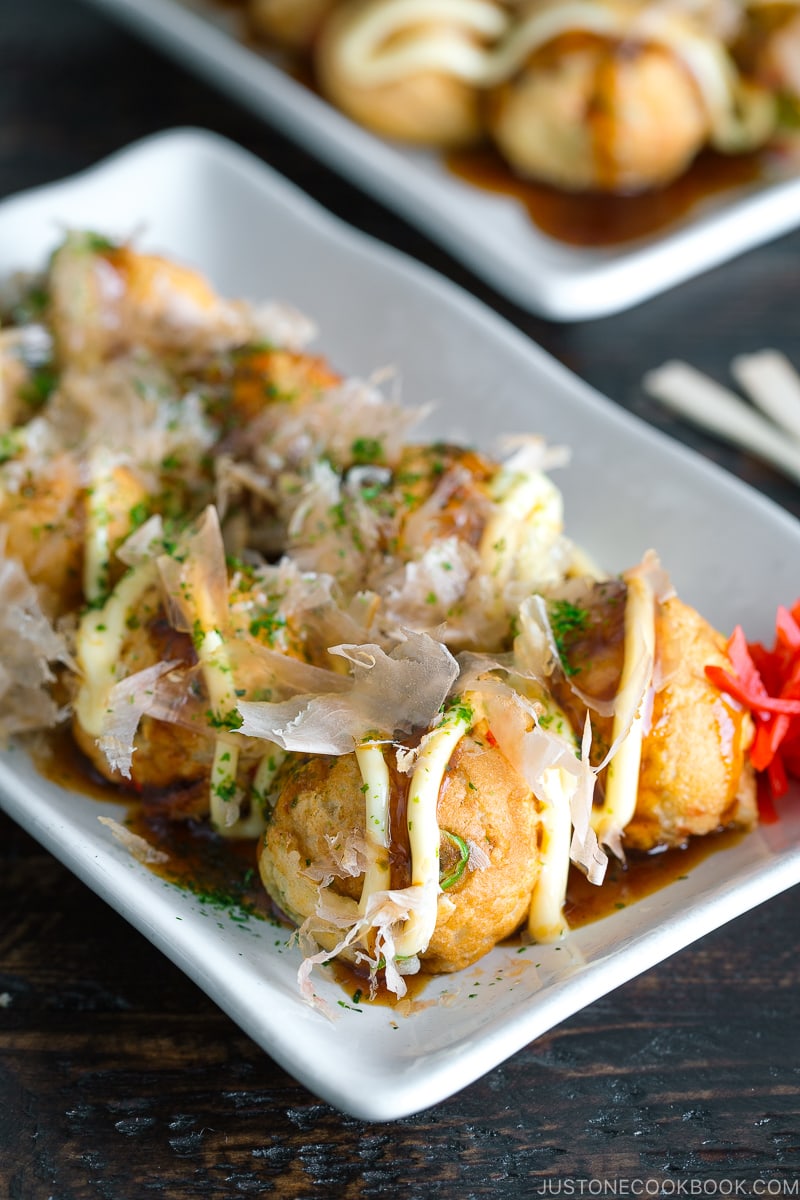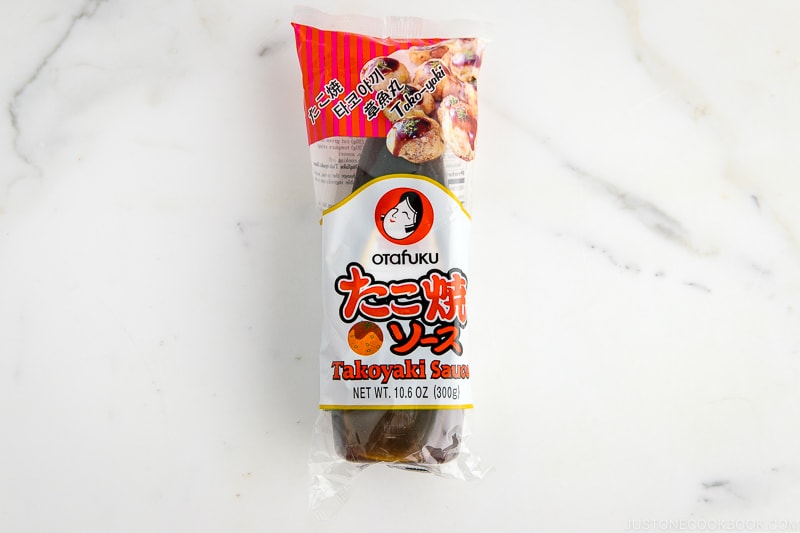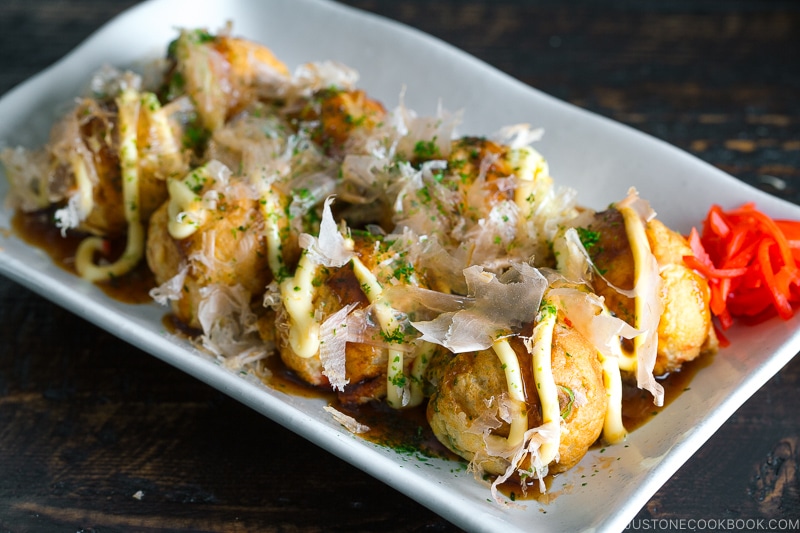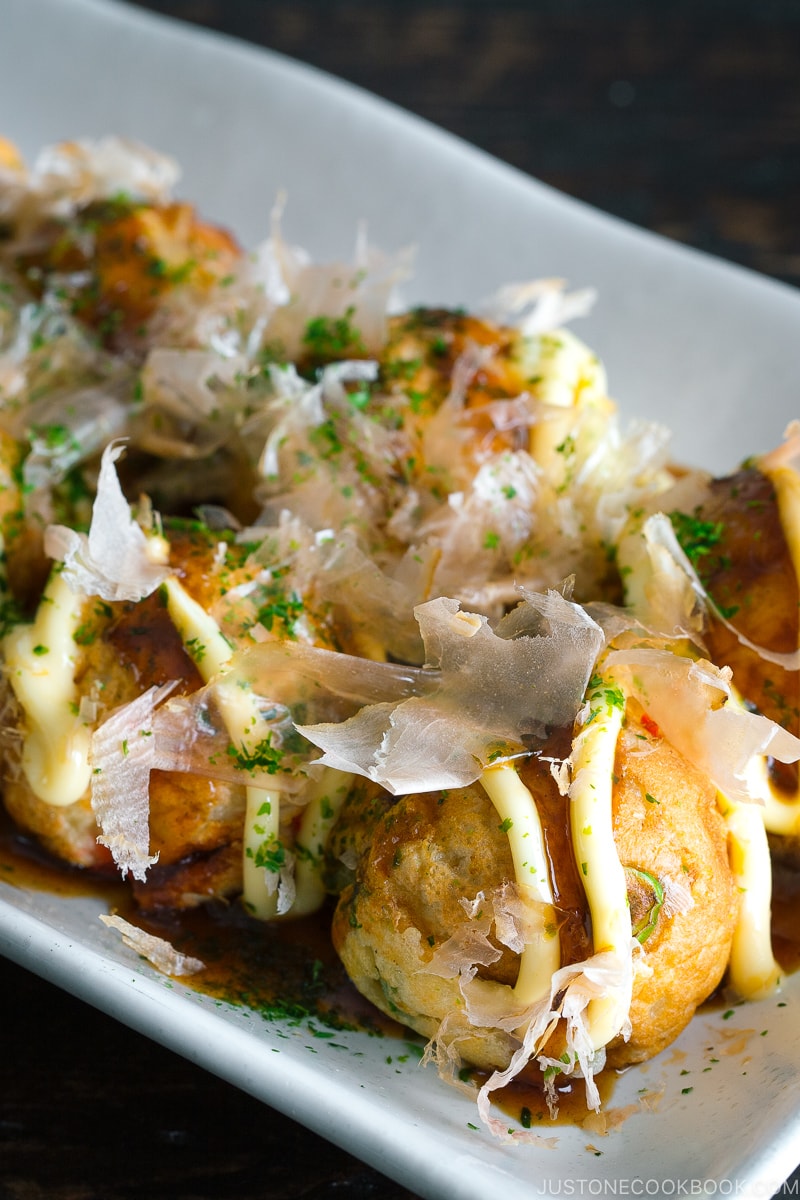Takoyaki, or Grilled Octopus Balls, originated in Osaka and are one of Japan’s best-known street foods. Whether you make a traditional style with bits of octopus or choose creative alternatives, these ball-shaped dumplings are fun to make with your friends and family!

Takoyaki (たこ焼き) is a Japanese snack in the shape of little round balls containing pieces of octopus. Tako-yaki literally translates to “octopus-grilled/fried” and some people may call it “Grilled Octopus Balls” or “Octopus Dumplings”.
What is Takoyaki
Here are some facts about takoyaki.

- It originated and became popular in Osaka around 1935 (according to wiki) and then spread to greater south-central Japan and beyond.
- It’s one of the most popular Japanese street foods along with Okonomiyaki.
- Takoyaki is usually sold by street vendors, convenience stores, supermarkets, food courts, and of course specialty restaurants. In Osaka, takoyaki stands can be easily found throughout the city.
- It is usually served with slightly salty takoyaki sauce, which goes well with beer and other alcoholic drinks. Therefore, many Izakaya restaurants serve takoyaki on the menu.

5 Ingredients for Authentic Takoyaki
There are so many variations of takoyaki throughout Japan. For example, the original Osaka-style does not include any cabbage, but many regional variations (Kyoto, Kobe, Nagoya, Tokyo areas) do. Even though I lived in the Tokyo area, I actually didn’t know they sometimes contain cabbage till now.
Here are the ingredients for the classic takoyaki recipe.
1. Dashi-flavored batter
Very simple. It’s a mixture of Japanese stock Dashi, all-purpose flour, baking powder, eggs, salt, and soy sauce. If you don’t want to make the batter from scratch, you can find takoyaki mix in Japanese grocery stores or Amazon.

2. Octopus
You can purchase cooked (boiled) octopus (tako in Japanese) in Japanese grocery stores. If you are going to make this snack for a big party, you can purchase a whole cooked octopus at an online sashimi store like Catalina Offshore. When I buy a whole octopus, I use it for different dishes, including sashimi, carpaccio, octopus salad (Takosu), and of course, takoyaki.
3. Beni shoga (pickled red ginger)
Small bits of beni shoga (紅生姜), or red pickled ginger, give a nice pop on the color of takoyaki and a little spicy, pungent kick to the dish.
4. Green onion
The batter is yellow, octopus, and beni shoga are red… and now you need green color to make the dish look more appetizing (and delicious)!
5. Tenkasu or Agedama (Tempura scraps)
I often get questions about what Tenkasu does for the dish. We use tempura scraps for hot or cold Tanuki Udon Noodles and Okonomiyaki (even Hiroshima-style). The oil from Tenkasu adds richer and umami flavors, and additional crispness and creaminess inside takoyaki balls.

Takoyaki Sauce & Garnish
Takoyaki is served with Worcestershire sauce-like “takoyaki sauce”, followed by some squirt of Japanese mayo. You can:
- Buy a store-bought takoyaki sauce
- Make a quick homemade takoyaki sauce (recipe) with several condiments
Then it’s topped with a sprinkle of a few garnishes:
- Aonori (dried green seaweed)
- Katsuobushi (dried bonito flakes)
3 Tips to Make Perfect Takoyaki
I received many requests for this recipe from JOC Readers (thank you!). To make the recipe as authentic as possible, I asked my best friend Yukako who lives in Osaka. She makes delicious takoyaki at home and she and her husband shared their own recipe with me and JOC readers. Yay! I adapted the recipe a little bit so that some ingredients will be easier to measure.
Tip 1: Don’t be stingy with the oil.
Apply generous oil everywhere (each hole in the takoyaki pan and surrounding flat area). How generous? You should see 1/4 inch (5 mm) oil in each hole. The oil helps takoyaki to have crispy skin and it’ll be easier for you to flip without the batter being stuck.
Tip 2: Generously pour the batter.
When you see smoke coming out of the grill/plate, fill the hole with the batter. If it overflows, that’s okay. Because the entire grill top should be covered with the batter after adding octopus and other ingredients in the hole. If you use a bigger chunk of octopus pieces, you might want to pour just enough to the top of the holes. As soon as the octopus goes in, it overflows naturally.
Tip 3: Flip 90 degrees and stuff in the extra batter.
Break the extra batter around the hole with skewers. Once the bottom of the takoyaki balls is crispy, rotate 90 degrees to let the uncooked batter pour out into the hole. Stuff and push in the extra surrounding dough inside the balls. This will help make a perfectly round shape.
For a home takoyaki grill, each hole doesn’t provide the same amount of heat. Therefore, it’s important to switch around the balls once they are in a ball shape so they’re browned evenly.

Don’t Like Octopus? Here Are Substitutions!
No problem! A lot of Japanese children enjoy different fillings besides pieces of octopus. Here are my suggestions for other fillings.
- Sausages / Bacon
- Canned tuna / Mentaiko (Spicy cod/pollock roe)
- Shrimp / Squid
- Cheese
- Mochi (rice cakes)
- Fish cake (chikuwa/crab sticks)
- Kimchi
- Corn
- Edamame
- Green peas
- Avocado
Various Takoyaki Grills
1. Zojirushi Gourmet Sizzler Electric Griddle + EA-YBC01 Takoyaki Plate (Optional) ($130 + $60)

This is the takoyaki grill pan that I use. I use this electric griddle for Teppanyaki and Okonomiyaki. I switch the hot plate to the takoyaki plate when I make Takoyaki.
2. Iwatani Cassette Gas Takoyaki Device ($100)

3. Iwatani Non-Stick Takoyaki Grill for Cassette Butane Stove ($40)

Do you have this Iwatani cassette feu butane stove already? I use this exact model for doing a hot pot at the table and sometimes filming my YouTube videos. If you have one already, then you can purchase this Iwatani accessory. The grill is non-stick and prevents food from sticking to the pan.
4. Yamazen Takoyaki Device ($45)

5. Ebelskiver (Danish) Pan ($25)

Many JOC readers told me they successfully made takoyaki with an Ebelskiver (Danish) pan or Appam Maker (Indian) as well.
Other Japanese Street Foods
- Yakisoba
- Okonomiyaki
- Taiyaki
- If you are interested in learning about Japanese Street Foods, check out Japanese Summer Festival Foods.

Wish to learn more about Japanese cooking? Sign up for our free newsletter to receive cooking tips & recipe updates! And stay in touch with me on Facebook, Pinterest, YouTube, and Instagram.

Takoyaki (Grilled Octopus Balls)
Video
Ingredients
- ¼ cup katsuobushi (dried bonito flakes) (I use the type with bigger flakes)
- 2 green onions/scallions
- 1 Tbsp pickled red ginger (beni shoga or kizami beni shoga) (store bought or make homemade Beni Shoga)
- 4.2 oz octopus sashimi (boiled octopus) (found in Japanese grocery stores; or substitute with sausage, corn, edamame, cheese, small mochi pieces…the choices are endless!)
For the Batter
- 1 cup all-purpose flour (plain flour)
- 2 tsp baking powder
- ½ tsp Diamond Crystal kosher salt
- 2 large eggs (50 g each w/o shell)
- 1 tsp soy sauce
- 1½ cups dashi (Japanese soup stock) (use standard Awase Dashi, dashi packet or powder, or Vegan Dashi)
For Cooking
- 2 Tbsp neutral oil
- ⅓ cup tenkasu/agedama (tempura scraps)
For the Toppings
Instructions
- Gather all the ingredients.

To Prepare the Filling
- Grind ¼ cup katsuobushi (dried bonito flakes) into a fine powder. Set aside to use during cooking.

- Cut 2 green onions/scallions into thin slices and mince 1 Tbsp pickled red ginger (beni shoga or kizami beni shoga).

- Cut 4.2 oz octopus sashimi (boiled octopus) into bite-sized pieces about ½ inch (1.3 cm); I use the rangiri cutting technique. Tip: Cut it into smaller pieces so it's easier to chew, especially for kids.

To Make the Batter
- Combine 1 cup all-purpose flour (plain flour), 2 tsp baking powder, and ½ tsp Diamond Crystal kosher salt in a large mixing bowl. Whisk it all together.

- Add 2 large eggs (50 g each w/o shell), 1 tsp soy sauce, and 1½ cups dashi (Japanese soup stock) to the bowl.

- Whisk until well blended. Transfer it to a handled measuring cup or any pitcher with a spout for easy pouring.

To Cook the Takoyaki
- Heat the takoyaki pan to 400ºF (200ºC) over medium heat. Use a brush to generously grease the rounded chambers and flat top surface with 2 Tbsp neutral oil. When the oil starts to smoke, pour the batter to fill the chambers. It’s okay to slightly overfill the cavities. In the next steps, the batter will likely overflow as you add more ingredients to it.

- Add 1–3 octopus pieces, depending on their size, to each chamber and sprinkle the ground katsuobushi powder on top.

- Sprinkle ⅓ cup tenkasu/agedama (tempura scraps), the green onion slices, and the chopped pickled red ginger on top. After 3 minutes or so, when the batter on the bottom has set and is slightly crisp, use skewers to break the connected batter on top between the chambers. Rotate each piece 90 degrees (a quarter turn) toward the bottom of the pan. Stuff the connected dough back into the ball as you turn; the uncooked batter will flow out from inside to create another side of the ball. After you finish turning them, set a timer for 4 minutes.

- After 4 minutes, rotate them again, starting with the first ball. Turn each takoyaki another 90 degrees toward the bottom of the pan so the remaining uncooked batter pours out into the chamber to complete the ball shape. Home takoyaki griddles don‘t distribute heat evenly, so it’s a good idea to swap the balls around to different chambers so they brown evenly. After turning and cooking for another 4 minutes, they are done.

To Serve
- Transfer them onto a plate and drizzle with ½ cup takoyaki sauce and Japanese Kewpie mayonnaise. Sprinkle with katsuobushi (dried bonito flakes) and aonori (dried green laver seaweed) and serve with a side of pickled red ginger (beni shoga or kizami beni shoga). Serve immediately. (But, be careful—they‘re VERY hot inside!)

To Store
- You can keep the leftovers in an airtight container and store in the refrigerator for 3 days or in the freezer for 2–3 weeks.
Nutrition
Editor’s Note: The post was originally published on Oct 20, 2013.










I love using this recipe to make takoyaki, but lately it’s been hit or miss. My batter turns out too thick and chunky, even when I double the dashi to try to thin it out.
Should dashi made from dried mushrooms work the same as seeweed dashi? I feel like it’s always when I use the mushroom dashi that it fails me.
Hi Laura! Thank you for trying Nami’s recipe and for sharing your experience with us!
The type of dashi shouldn’t make too much of a difference in this case. We’re just wondering if you measure your flour by weight each time. Using measuring cups can sometimes be a bit inconsistent.
We hope this helps, and we’d love to hear how it goes next time!
This was so amazing! I used Korean pajeon mix which has flour, salt, baking powder but some onion and garlic powder as well and it worked perfectly with the recipe. We used optopus from Spain which Costco stocks around the holidays (and we stock up and freeze).
Hi, Cory! Awesome! Thank you very much for sharing your experience!
We’re glad everything worked out for you and you enjoyed the homemade Takoyaki.
Happy cooking! 🥰
Hey Nami! I just discovered Japanese food and ordered my first takoyaki griddle. I can’t yet splurge on the equipment that you have. So, the issue is that I have an electric stove, not a gas stove with an open flame. Have you ever used a takoyaki griddle on an electric stove?
Hi, Adam! Thank you for reading Nami’s post.
Which takoyaki griddle did you get? If it’s a cast iron pan, it should work on an electric stove, but please check the user manual for your takoyaki pan.
Nami used Zojirushi’s electric type in this post.
We hope this helps!
Yes, I’ll definitely get the Zojirushi soon! As for now, I got the Iwatani Takoyaki Grill Pan from Amazon.
Hello, Adam. According to their description, the Iwatani grill pan featured above is best used with a gas burner. We have never tried it on an electric stove, so we are unsure whether it would work. But I spotted someone using an electric cooktop in the review video!
Hi there I’ve been using your recipes for a while now and have been loving them, so I recently tried takoyaki.
I couldn’t find a takoyaki pan locally but I found a cake pop griddle and It makes perfectly round takoyaki. A bit smaller than normal but still great.
Thank you for all the amazing recipes.
Hello, Thomas! What a brilliant idea! Thank you for trying Nami’s recipe and sharing your results with us.😊
We’re glad it went well and that you enjoyed the recipe.
Happy Cooking!
How in the world did you grind the katsuoboshi?? The type I got from Amazon (Yamaki tuna) is very flexible, so simply crushing it doesn’t seem to break it down. 🙁 Thank you for replying!
Hello there, Heather! Thank you so much for trying Nami’s recipe!
Do you have a grinder? You can use an electric one or a pestle and mortar (Suribachi).
We hope this helps!
Thank you so much for the recommendation, Naomi!! …I’m definitely getting a suribachi next I make it! This time around it was alreafy on the night of my birthday, so it was too late to order anything, lol I managed to grind it with a blender wand and a glass mixing bowl–i think it took like 30 minutes XD
…so a suribachi will definitely make it easier next time!
I do have another question…..
I ran into an issue where the outside was almost burnt, but it was paper thin, and the inside was so tender, that it was difficult to lift them off the grill without squishing them.
Do you think next time I should try and heat it at 350°F instead of 400°F…or would that risk making them too firm?
(btw, I used the same Zojirushi grill as Nami, if that helps)
Hello, Heather! You are most welcome! Thank you for sharing your Takoyaki photo as well! It looks fantastic!
Regarding the cooking temperature, you may reduce it to 375°F next time or rotate the Takoyaki a little earlier each time so that it doesn’t get hot and burn.
The best Takoyaki texture is crisp on the outside and tender on the inside.
We hope this was helpful!
HI Nami, I made Takoyaki yesterday, followed your recipe and method. They were quite solid, the batter cooked almost like solid pancake and they weren’t smooth and round and they had a ridge around the diameter. I cooked the over a gas ring on the cooker. Maybe the heat was too strong? Going to try and make them again tomorrow so could do with advice. Maybe I should use a camping stove-the heat might be les intense? Any advice appreciated
Niav McNamara
Hello, Niav! Thank you so much for trying Nami’s recipe! 🤗
It sounds like your Takoyaki was overcooked. Why not stake another gas ring on top if you can’t lower the frame? It will give you an extra hight from the frame. We hope this method works for you!
Hi Nami, can I make the batter two days ahead?
Hello Agung, Thank you for taking the time to read Nami’s post and trying her recipe.
You can store the batter in the fridge for up to one day, but be careful not to keep it there for too long as it contains eggs. We hope this information is helpful to you.
In which of your cookbooks can I find this recipe?
Hi Susan, Thank you so much for reading Nami’s post and trying her recipes!
Nami’s cookbook currently does not feature this Takoyaki recipe. Sorry!
Nami, are there any other recipes for the takoyaki pan in Japan? i.e. potato balls or variations of takoyaki using something else like oysters? Or something sweet, similar to a sesame ball?
Hi Ralph, Thank you so much for trying Nami’s recipe!
As Nami mentioned in this post, there are so many variations of Takoyaki throughout Japan (please see substitution recommendations). Especially when people gather for a Takoyaki party, they become very creative.
You can also use pancake batter and add Anko (sweet beans) to make a little dessert ball as well.
We hope you have fun experimenting with different ingredients.
Hi there. Thank you for this thorough recipe! For mochi, what kind of mochi is typically use? I keep kiri mochi blocks on hand for yakitori.
Hi Meli! Thank you for reading Nami’s post and trying her recipe!
Yes! Kiri Mochi works great. You can cut it into small cubes and add them.
We hope this helps!
Thank you for sharing your recipe! My son and I just enjoyed a nice time together figuring this out and it was very tasty. It was fun to turn each ball. It looks like such a disaster and then poof it’s tidy. Very fun and delicious.
Hi Jill! Thank you for trying Nami’s recipe and sharing your cooking experience with us!
We are so happy to hear you and your son enjoyed making Takoyaki!
Happy Cooking! 💞